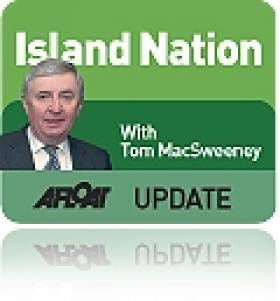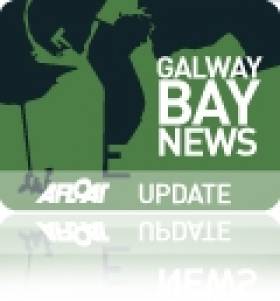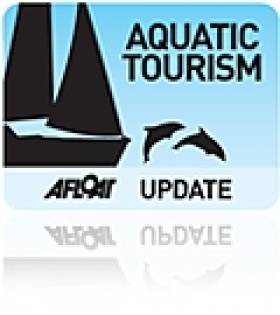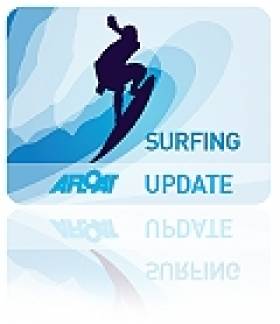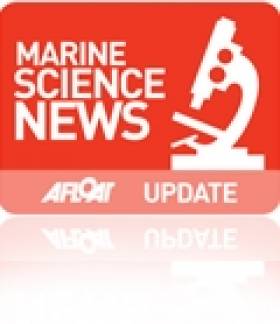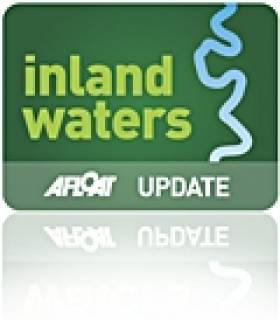Displaying items by tag: tourism
Marine is Back
It is a reminder which I hope that the media in general will note and that his tile of Marine will be used as often as agriculture is. The general media has been notorious, in my view, for disregarding the marine sector unless there is disaster, emergency or controversy involved.
The return of the title 'Marine' to a Government Department is, to put it bluntly, a kick-in-the-ass which civil servants needed. It was a betrayal of this island nation's heritage when those in charge of the former Department of Transport held a meeting which decided to remove the title marine from the Department's name, even though the then Minister had been assigned the role of Minister for Transport and Marine. The man in charge of that Department, Noel Dempsey, did not demonstrate a lot of interest in the marine, being more noted for trying to shut down the coastal radio stations at Valentia and Malin, where he was beaten off by public opposition, which also happened when he tried to remove 24-hour rescue helicopter service in the south-east and for his introduction of laws which criminalised fishermen.
Hopefully, the restoration of 'Marine' to a Department's name will be the harbinger of better things for the marine sphere.
I have heard some disappointment expressed that the marine is not a department on its own, but what the Fine Gael and subsequently Coalition Programme for Government agreed by Enda Kenny and Eamon Gilmore said was: "Marine responsibilities will be merged under one Department, for better co-ordination in policy delivery."
They have been, though some of the finer detail remains to be seen, such as will the ports be moved away from Transport, to where port companies and commercial interests originally campaigned to have them moved? And how will the split of marine tourism work between Agriculture and Marine and the separate tourism department? A similar issue may arise in regard to sailing and sport, but it seems to me a positive step that the disregard which Fianna Fáil and the Greens showed for the marine sector is being changed.
It was also right to end a separate department for defence. With a small army and navy, smaller than the marine sector, it was nonsense that it should have been a department of its own.
Let us therefore, hope for the future and take a positive view of the change as being for the better.
Programme for Government will Reinstate Marine Department
It maybe the second last item on the programme for government issued by Enda Kenny and Eamon Gilmore yesterday but the indications are good that the marine sector will see a reinstated Department of the Marine. the Fine Gael and Labour coalition say 'marine responsibilities will be merged under one Department, for better co-ordination in policy delivery'. Here is the relevant excerpt:
Coastal communities, fisheries & marine environment
We will negotiate the best possible deal for fishermen in the review of the Common Fisheries Policy.
We will support the development of sustainable aquaculture and fish farms by streamlining the licensing process and reducing associated bureaucracy.
Marine responsibilities will be merged under one Department, for better co-ordination in policy delivery. We will develop an integrated marine and coastal planning process in order to maximise the potential of Ireland's coastline in fishing, aquaculture, ocean energy and tourism.
A Sea Fisheries Sustainability Impact Assessment, based on consultation with all major stakeholders, will be brought before the Dáil annually before EU fisheries negotiations commence.
We will replace criminal sanctions system for minor fisheries offences with administrative sanction system to bring Ireland into line with other European jurisdictions. Safety at sea and decent working conditions must underpin the development of the fisheries sector. We will explore the provision of an emergency towing vessel for the Coastguard.
City Powerboat School on the Market
Due to an opportunity for its owners overseas Dublin City's only powerboat training school, City Powerboat School is on the market. The Irish Sailing Association recognised training establishment is advertised in next week's edition of Afloat magazine. The school operates in the 'highly visible' River Liffey area. School principal Felix Finlay says 'the position of the school in Dublin City has attracted many enquiries, for not only powerboat training courses, but sail training, tourism activities, and educational opportunities'. More here.
Public Views Galway Harbour Plans This Weekend
Plans for the development of Galway Harbour are open for public consultation this weekend, The Irish Times reports.
The Galway Harbour Company's €200 million scheme involves moving the port south onto 24 hectares of reclaimed land in deeper water to accommodate cruise liners.
A new rail link is also proposed, as well as an expanded marina with more than 200 berths.
The company's chief excecutive Eamon Bradshaw said the first stage of the plan would be self-financed, but did not rule out the possibility of EU funding, public-private partnerships and private investment.
Pending planning approval, development is hoped to begin at the end of 2012 - some months after Galway welcomes the return of the Volvo Ocean Race.
Thr Irish Times has more on the story HERE.
South-East's Coast, Rivers Hold Tourism Potential
Tourist anglers spent €89.9 million in Ireland in 2008, a marine leisure conference in Co Waterford heard recently.
The importance of angling to the economy was highlighted at the Rising Tide seminar in New Ross, an event focused on developing historical connections between Ireland and Newfoundland in Canada in the areas of fisheries, development and coastal tourism.
Speakers noted the "strong maritime tradition" along the south-east coast, the potential of the Waterford Estuary as a gateway to the region's inland waterways, and opportunities for development to tie in with next year's visit of the Tall Ships.
Minister of State for Fisheries, Sean Connick TD, also announced funding of €156,000 for Wexford harbours in tandem with Wexford County Council's allocation of €52,000.
The Irish Times has more on the story HERE.
Prowlers Could Boost Tourism in West
The 50ft monster waves that arose off Ireland's west coast last week could provide a significant boost to tourism in the region.
Ethna Murphy of Fáilte Ireland told The Irish Times that images and news reports of the Prowlers waves has given them "priceless publicity" ahead of next autumn's European Surfing Championships in Bundoran.
"Those photographs will be in every surfing magazine in the world that matters and that is how we attract visitors to Ireland," added Killian O'Kelly of Bundoran's TurfnSurf Lodge surf school.
Last week's Fáilte Ireland conference on adventure tourism in Killarney was told that the market is worth over €1 billion annually, attracting over a million visitors to Ireland each year.
Prowlers has enhanced Ireland's already growing reputation as one of the top cold-water surfing spots in the world.
But the location of the giant waves as yet remains a secret known only to a handful of intrepid surfers.
Galway Atlantaquaria Nets Second Education and Outreach Award
Galway Atlantaquaria who, with the Marine Institute, Forfas Discover Primary Science and others are partners in the Explorers marine education and outreach programme, have achieved their second prestigious award - Best Education Project : Public and General Visitor 2010 - from the Britain and Ireland Association of Zoos and Aquaria (BIAZA) for their marine education and outreach activities.
The award, was presented at Paignton Zoo Environmental Park, Devon by Adrian Sanders MP and was given for the "Galway Marine Month of Madness" event, organised by the Atlantaquaria with help from the other Explorers partners during the month of May this year.
Speaking for the Atlantaquaria, Marketing Executive Colette Lavin said that the award was a tribute not only to the Atlantaquaria but to all those involved in the month-long celebration. "A lot of people put a lot of heart and hard work into the individual events that made up the Month of Marine Madness," she said. "And while this second BIAZA award is the most tangible benefit of all this, I really believe that the biggest reward for all our efforts is the raised awareness of the value of our oceans and seas, not only to Galway, but to the rest of the country."
The calendar of events was launched by Galway's Deputy Mayor Mr. Peter Keane at Salthill beach and events arranged during the Month of Marine Madness ranged from seashore safaris, diving lessons, scientific lectures, nature walks and angling demonstrations, to a series of free seminars at the Atlantaquaria on such subjects as Baleen Whales, Slimy
Seaweed, the value of outdoor education, and Pirates! The First Entrepreneurs. A highlight of the calendar was the 'Largest Beach Clean Up in Ireland' which took place on Sunday 18th of May. Over 2,000 members of the public took part in the various events which included a tour of the national research vessel RV Celtic Explorer by 280 pupils from local primary schools.
Speaking for the Explorers Programme, Dr. John Joyce of the Marine Institute said that the effort put in by Colette and her team had raised awareness of the sea to a whole new level in Galway during the month of May. "While Explorers is targeted primarily at raising awareness of the sea in schools, Colette and the Galway Atlantaquaria have shown us how we can raise that awareness to a whole new level by reaching out into the wider community. Last year, the Volvo Ocean Race vividly demonstrated the value of the sea to Galway in terms of tourism revenue. Clearly, the way is open to build on that awareness
and to use our creativity in finding new ways that Galway can profit - financially, educationally and environmentally – from marine related events."
Galway Atlantaquaria, the Marine Institute and the other partners in the Explorers programme celebrated the launch of National Science Week on Sunday 7th November with a Sunday Funday entitled "Our Plaice in Space" to celebrate the connections between outer and inner space.
Later in the month, on November 21st, the Explorers Programme will be present at the Galway Science and Technology Festival in NUI Galway.
'Keenan's of Tarmonbarry' Wins Taste Of Waterways Award
The winner of the prestigious Taste of the Inland Waterways Award was revealed this week by Georgina Campbell as "Keenan's of Tarmonbarry".
Presenting the Taste of the Waterways Award to Keenan's of Tarmonbarry, Martin Dennany, Director of Marketing and Communications, Waterways Ireland stated "Keenan's of Tarmonbarry epitomises the waterway dining experience and I am delighted to present this Taste of the Waterways Award and to commend Georgina Campbell on her choice. With the recent completion of the link between the Royal Canal and the Shannon Navigation, we hope that many will take the opportunity to visit the area and to experience for themselves the delights of waterside hospitality at this fine establishment. Waterways Ireland is happy to sponsor this award and to recognise the contribution that businesses like Keenan's make to the tourism industry".
The Taste of the Waterways Award was first introduced in 2008 and runs in conjunction with "The Taste of Waterways" booklet, a publication produced by Waterways Ireland in partnership with Georgina Campbell highlighting the excellent hospitality of the waterway experience. The guide is free and updated regularly with Georgina's selection of establishments of all kinds serving food and hospitality all along the inland waterways.
Martin Dennany commenting on the guide stated "The judging criteria and standard of assessment for the Taste of the Waterways Georgina Campbell guide is very high, with selection made on merit alone: no payment is charged for entry, no payments accepted for advertising".
Georgina Campbell described Keenan's as "Just beside the bridge over the Shannon in Tarmonbarry, this well-run bar and restaurant has been a favourite watering hole for river folk for many years - and it makes a great place to break a journey between Dublin and the north-west. The range is wide, offering wholesome, hearty fare that pleases all age groups and includes very welcome traditional dishes. But it's for their steaks, above all, that people beat a path to Keenan's of Tarmonbarry - and why wouldn't they? Whether you go for a classic sirloin, a big juicy fillet, or their renowned steak sandwich, the steaks at this hospitable watering hole are not to be missed."


























